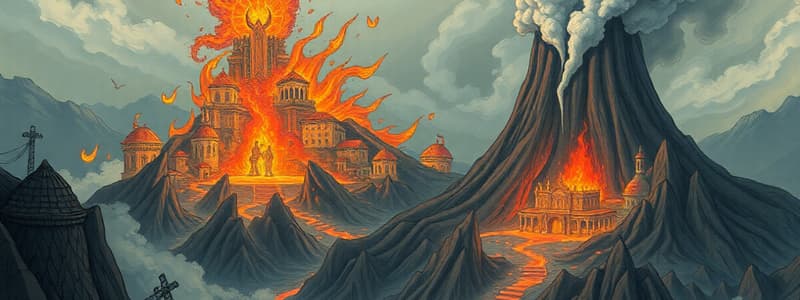Podcast
Questions and Answers
Which of the following natural disasters is characterized by a spinning column of air descending from a storm cloud?
Which of the following natural disasters is characterized by a spinning column of air descending from a storm cloud?
- Tornado (correct)
- Tsunami
- Earthquake
- Hurricane
Wildfires can only be started by natural causes, such as lightning.
Wildfires can only be started by natural causes, such as lightning.
False (B)
What is the name for the hot liquid rock that erupts from a volcano?
What is the name for the hot liquid rock that erupts from a volcano?
lava
A __________ is a large wave caused by an earthquake or a volcano under the ocean.
A __________ is a large wave caused by an earthquake or a volcano under the ocean.
Match the natural disaster with the appropriate safety measure:
Match the natural disaster with the appropriate safety measure:
Hurricanes are characterized by which of the following conditions?
Hurricanes are characterized by which of the following conditions?
It is safe to walk or swim in floodwaters as long as you are a strong swimmer.
It is safe to walk or swim in floodwaters as long as you are a strong swimmer.
During an earthquake, what should you do to protect yourself from falling debris?
During an earthquake, what should you do to protect yourself from falling debris?
Before a natural disaster occurs, it is important to prepare a __________ with essential supplies such as food, water, and a flashlight.
Before a natural disaster occurs, it is important to prepare a __________ with essential supplies such as food, water, and a flashlight.
When a tsunami warning is issued, what immediate action should be taken?
When a tsunami warning is issued, what immediate action should be taken?
Flashcards
Earthquake
Earthquake
Shaking of the ground caused by movement deep inside the Earth.
Volcano
Volcano
A mountain that can explode, releasing lava, ash, and gases.
Hurricane
Hurricane
Big storms with strong winds and heavy rain, formed over warm ocean water.
Tornado
Tornado
Signup and view all the flashcards
Flood
Flood
Signup and view all the flashcards
Wildfire
Wildfire
Signup and view all the flashcards
Tsunami
Tsunami
Signup and view all the flashcards
Earthquake Safety
Earthquake Safety
Signup and view all the flashcards
Tsunami Safety
Tsunami Safety
Signup and view all the flashcards
Disaster Kit
Disaster Kit
Signup and view all the flashcards
Study Notes
- Natural disasters are powerful events, capable of inflicting substantial damage and posing significant dangers.
- These events occur naturally, triggered by the Earth's internal processes and weather patterns.
- Studying these events enhances our understanding of safety measures.
Types of Natural Disasters
- Earthquakes: Ground shaking events caused by subterranean movements.
- Earthquake intensity varies, ranging from imperceptible tremors to catastrophic events capable of collapsing buildings.
- Volcanoes: Mountains with the potential for explosive eruptions.
- Eruptions involve the release of lava, ash, and gases.
- Volcanoes can reshape landscapes and present hazards in proximity.
- Hurricanes: Large-scale storms characterized by intense winds and heavy rainfall.
- Hurricanes originate over warm ocean waters.
- Potential effects of hurricanes include flooding, structural damage, and deforestation.
- Tornadoes: Rotating columns of air descending from storm clouds.
- Tornadoes are visually characterized by their funnel shape.
- Their destructive potential arises from rapid movement and ability to obliterate anything in their path.
- Floods: Water excess in a particular area.
- Floods can result from heavy rainfall, river overflow, or coastal inundation.
- Consequences of flooding include building submersion, street closures, and transportation disruptions.
- Wildfires: Extensive, rapidly spreading fires that consume forests, grasslands, and brushlands.
- Wildfires can be ignited by lightning, unattended campfires, or accidental means.
- Wildfires can decimate homes and endanger wildlife.
- Tsunami: Massive ocean waves triggered by underwater earthquakes or volcanic eruptions.
- Tsunamis exhibit high-speed travel across oceans.
- They unleash extensive destruction upon coastal impact.
What to Do During a Natural Disaster
- Earthquakes: During an earthquake, drop to the ground, protect your head and neck, and hold onto a sturdy object. Stay away from windows.
- Volcanoes: Follow adult guidance during volcanic eruptions, which may include evacuation.
- Hurricanes: Stock up on essential supplies (food, water) and identify a safe location. Remain indoors away from windows during the storm's duration.
- Tornadoes: Seek shelter in a basement or an interior room devoid of windows.
- Floods: Avoid contact with floodwaters; do not walk or swim through them.
- Wildfires: Follow adult instructions and prepare for potential home evacuation.
- Tsunami: In the event of a tsunami warning, immediately seek higher ground.
How to Prepare for Natural Disasters
- Make a Plan: Preemptively discuss natural disaster responses with family members.
- Know the Risks: Familiarize yourself with potential natural disasters specific to your geographical area.
- Have a Kit: Assemble an emergency kit containing food, water, a flashlight, and a first-aid supplies.
- Listen to Grown-Ups: Adhere to instructions from parents, teachers, or other responsible adults.
Studying That Suits You
Use AI to generate personalized quizzes and flashcards to suit your learning preferences.




